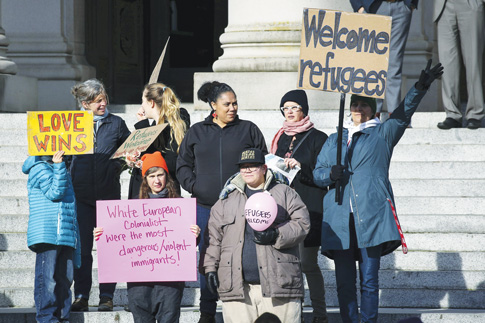
By Christopher White
The Tablet National Correspondent
As the Oct. 1 deadline looms for President Donald Trump to decide how many refugees the United States will accept during the next fiscal year, the U.S. Conference of Catholic Bishops is pushing back against efforts to severely curtail the number of refugees welcomed into the country.
Since the Vietnam War, the Catholic Church has been the nation’s largest organization involved in the resettlement of refugees. Following the war, some 800,000 Vietnamese were resettled in the United States alone.
Today, the Trump administration is looking to set the ceiling at 50,000, an unprecedented low.
There are nine resettlement agencies in the United States, with the Catholic Church’s Migration and Refugee Services being the largest. Six of the agencies are faith-based.
In 1980, Congress passed the United States Refugee Act of 1980, which established the official procedure for government assistance and resettlement to individuals and families seeking refuge, and authorized the president to determine a set number of refugees that could be accepted. The legislation was strongly backed by the U.S. bishops at the time.
In signing the act, President Jimmy Carter said it would “help refugees in this country become self-sufficient and contributing members of society.”
“Until now, resettlement has been done primarily by private persons and organizations. They have done an admirable job, but the large numbers of refugees arriving now create new strains and problems,” Carter added.
Officials from Migration and Refugee Services told The Tablet that they are hoping the presidential determination reached by Trump will be at least 75,000 individuals, as Congress has already approved funding for that many.
Last year, Migrations and Refugee Services resettled 20,000 refugees in the U.S., and historically the office has been responsible for approximately 30 percent of the resettlement that takes place in the country.
In 2010, the USCCB launched a new initiative, Parishes Organized to Welcome Refugees, or the POWR program, as it’s more commonly known.
The POWR program was designed specifically to encourage and organize volunteer efforts at the parish level.
Since 2010, the program has been responsible for welcoming 31,000 newcomers from over 50 countries. Over 14,500 parish level volunteers have supported the program.
According to the office of Migrant and Refugee Services, “the visit of the Holy Father to the U.S. had triggered an outpouring of support from refugee-receiving communities. Multiple POWR programs are reporting a significant increase in donations and volunteer interest.”
Chris Crawford, a parishioner at Holy Trinity Catholic Church in Washington, D.C., told The Tablet that the experience of his parish welcoming a family of eight from Syria earlier this year has been one of the most significant events of his life.
His parish’s social justice committee began to explore the option of welcoming a refugee family in response to the multiple refugee boats that were capsizing in the Mediterranean Sea and attracting international headlines.
Over a hundred and fifty parishioners volunteered to help – agreeing to provide food, clothing, and find an apartment for the family of eight, with children ages one through 13, and whose father was disabled and required special housing arrangements.
After being informed about the family, Crawford said he was initially hesitant that they could take on such a responsibility, but eventually felt they had no other choice.
“My first instinct was: We can’t do this, this is going to be too heavy a lift. But by the end…we had this feeling that if it’s not us, who is it going to be?” said Crawford.
“We really felt that we had this obligation, and by the end we really felt that they were our family before we even knew their names,” he said.
Yet the parish experienced a temporary setback when President Trump issued the first version of his travel ban in January that barred Syrians from entering the U.S.
“We went to the Hill and lobbied Congress with our story, explaining this is a family of eight, they have a baby, the dad has a disability, and these are the people you blocked,” Crawford said.
After legal relief was sought, the family was eventually allowed to enter the U.S.
“Having it be such a difficult process actually made us feel a stronger connection with our family,” said Crawford. “They’ve been here about seven months and…it’s been challenging at times, but it’s been rewarding all the time.”
In his speech at the United Nations General Assembly last week, President Trump said the U.S. was a compassionate country but would seek to help refugees settle closer to their home countries.
William Canny, executive director of Migration and Refugee Services, told The Tablet that he shares those same desires but worries about the estimated one million refugees that can’t go home or stay in the country from where they fled, and that’s why the U.S. bishops are advocating for a higher number to be allowed to come here.
Meanwhile, the president has less than a week to decide what that number will be.
